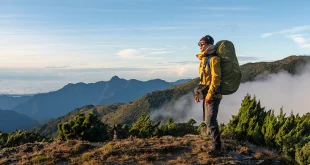As someone who enjoys spending time on hiking trails, I’ve learned over the years that adventure always comes with a bit of risk. Whether you're tackling a simple day hike or spending several days in the wilderness, the unpredictable nature of the outdoors means that accidents can happen at any moment. That’s why I believe carrying a hiking first aid kit is one of the most crucial steps you can take before heading out on the trail.
Over time, I've encountered numerous situations where a well-stocked first aid kit made all the difference. From blisters that could have ruined my hike to small cuts that needed immediate attention, the kit has allowed me to continue enjoying my outdoor excursions without worry. In this article, I’ll walk you through why you need a hiking first aid kit and provide tips on what to pack in it to ensure you're prepared for anything.
The Importance of Having a Hiking First Aid Kit
When I first started hiking, I was naive in thinking that I could simply "wing it" without the proper tools. But after a few hikes where minor injuries, like a twisted ankle or a small cut, turned into bigger problems, I realized how essential it is to carry a first aid kit. In the wilderness, there's often no immediate access to medical help, so being able to handle minor injuries or stabilize a more serious situation is key to staying safe.
Having a hiking first aid kit isn't just about having band-aids on hand for small cuts. It's about peace of mind and preparation. Accidents—whether it’s a sudden fall, a bug bite that turns into an allergic reaction, or a deep cut—are unpredictable. With the right supplies, you'll be able to minimize risks and even prevent minor issues from becoming more serious.
What Should You Pack in a Hiking First Aid Kit?
Throughout my many hikes, I’ve discovered what I believe to be the essential items for a hiking first aid kit. The goal is to be prepared without overpacking. Here’s a breakdown of what I recommend including:
Essential Supplies for Treating Cuts, Scrapes, and Other Injuries
- Adhesive Bandages
Whether it’s from a brush with a thorn or a fall, small cuts can happen anytime while hiking. I carry a variety of band-aids in my kit, including larger ones for bigger scrapes. These help seal minor wounds and prevent infection. - Gauze Pads and Adhesive Tape
If the injury is more significant, gauze pads are a lifesaver. They help to absorb blood and can be used to apply pressure to a wound. I always bring extra rolls of adhesive tape to secure the gauze in place, especially in case of deeper cuts. - Antiseptic Wipes
Keeping an injury clean is crucial to preventing infection. I carry individually wrapped antiseptic wipes that I can use to disinfect cuts and scrapes before applying bandages. This step reduces the chance of bacteria entering the wound. - Sterile Gloves
Handling injuries with sterile gloves is an important practice for minimizing infection. Whether I’m treating myself or helping a fellow hiker, I always ensure I have a pair of disposable gloves on hand to keep the injury area as clean as possible.
Medical Supplies for Emergency Situations
- Pain Relievers (Ibuprofen or Acetaminophen)
Hiking can be physically demanding, and sometimes you’ll need to manage muscle soreness or other pains. I always pack some basic pain relievers like ibuprofen or acetaminophen. These can help with anything from a headache to joint pain after a long hike. - Tweezers
For those pesky splinters or ticks that are common in the outdoors, a solid pair of tweezers is crucial. I also use them to remove plant material or debris from cuts. When removing a tick, it’s important to do it properly to avoid leaving part of the tick embedded. - Antihistamines
Allergies are something that can sneak up on you while hiking. Whether it’s pollen or an insect sting, having antihistamines in your hiking first aid kit can help relieve symptoms quickly. I’ve had moments when I’ve been grateful to have these on hand for mild allergic reactions. - Blister Treatment (Moleskin or Blister Pads)
Blisters are a common complaint among hikers. Having moleskin or blister pads ready to go can prevent a blister from getting worse. I make sure to apply these as soon as I feel a hotspot to avoid the pain and discomfort of a full-blown blister.
Specialized Tools for Serious Emergencies
- Burn Cream or Gel
While burns might not be an everyday occurrence on the trail, accidents with campfires or stoves can happen. I pack burn cream or gel to soothe and treat minor burns until I can get proper medical attention if necessary. - Insect Repellent and Bite Relief
Insects are a fact of life when hiking, and bites can lead to irritation or even infection. I carry an insect repellent to keep the bugs at bay and an anti-itch cream to soothe bites once they occur. - Emergency Blanket
An emergency blanket is lightweight but can be a lifesaver if the weather changes suddenly. These blankets trap body heat and help prevent hypothermia in case of an unexpected cold snap or if you get stranded. - CPR Face Shield
Though I’ve never had to use it, I always keep a CPR face shield in my hiking first aid kit. It’s a compact tool that allows you to administer CPR while protecting both the victim and yourself from direct contact.
How to Use Your Hiking First Aid Kit
It’s not enough to simply carry a hiking first aid kit; knowing how to use it is just as important. I’ve had situations where I had to act quickly and calmly to treat injuries on the trail. Below are some general guidelines for using your kit effectively:
Treating Small Cuts and Scrapes
- Step 1: Clean the area with antiseptic wipes to remove dirt and debris.
- Step 2: Apply pressure with gauze if the wound is still bleeding.
- Step 3: Cover the wound with an adhesive bandage or gauze to protect it and prevent further contamination.
Addressing Blisters
- Step 1: If you feel the beginnings of a blister, cover the area with moleskin or blister pads to reduce friction.
- Step 2: If the blister already forms, I carefully clean the area, drain it (if necessary), and protect it with a bandage to avoid further irritation.
Managing Allergic Reactions
- Step 1: Take antihistamines immediately if you experience itching, swelling, or trouble breathing.
- Step 2: If symptoms worsen, seek medical help as soon as possible. If you have an epinephrine injector, use it immediately.
Keeping Your Hiking First Aid Kit Organized
Over the years, I’ve also learned the importance of keeping my kit organized. A disorganized first aid kit makes it harder to find what you need in an emergency. Here are my tips for keeping everything in its place:
- Use zippered pouches to separate different categories of supplies (bandages, medications, tools).
- Check expiration dates on medications, bandages, and other supplies regularly to ensure everything is still good to use.
- Personalize your kit based on your needs. If you have allergies or specific medical conditions, make sure your kit includes items to address those needs.
Conclusion
A well-stocked hiking first aid kit is an investment in your safety and well-being on the trail. While you never hope to need it, being prepared can make all the difference in handling an injury or emergency. After years of hiking, I now carry a hiking first aid kit that fits my needs and gives me peace of mind during every adventure. By packing wisely and learning how to use the supplies, you can enjoy your hikes with confidence, knowing that you're prepared for anything the trail might throw your way.
 Best Hiking Gear Hike More, Worry Less
Best Hiking Gear Hike More, Worry Less

